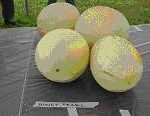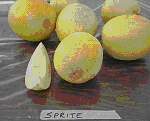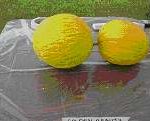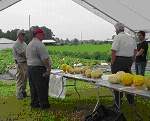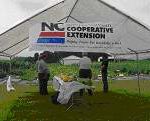Northeast Ag Expo Featuring Alternative and Specialty Crops, Including Specialty Melons-2003 Report
go.ncsu.edu/readext?452103
en Español / em Português
El inglés es el idioma de control de esta página. En la medida en que haya algún conflicto entre la traducción al inglés y la traducción, el inglés prevalece.
Al hacer clic en el enlace de traducción se activa un servicio de traducción gratuito para convertir la página al español. Al igual que con cualquier traducción por Internet, la conversión no es sensible al contexto y puede que no traduzca el texto en su significado original. NC State Extension no garantiza la exactitud del texto traducido. Por favor, tenga en cuenta que algunas aplicaciones y/o servicios pueden no funcionar como se espera cuando se traducen.
Português
Inglês é o idioma de controle desta página. Na medida que haja algum conflito entre o texto original em Inglês e a tradução, o Inglês prevalece.
Ao clicar no link de tradução, um serviço gratuito de tradução será ativado para converter a página para o Português. Como em qualquer tradução pela internet, a conversão não é sensivel ao contexto e pode não ocorrer a tradução para o significado orginal. O serviço de Extensão da Carolina do Norte (NC State Extension) não garante a exatidão do texto traduzido. Por favor, observe que algumas funções ou serviços podem não funcionar como esperado após a tradução.
English
English is the controlling language of this page. To the extent there is any conflict between the English text and the translation, English controls.
Clicking on the translation link activates a free translation service to convert the page to Spanish. As with any Internet translation, the conversion is not context-sensitive and may not translate the text to its original meaning. NC State Extension does not guarantee the accuracy of the translated text. Please note that some applications and/or services may not function as expected when translated.
Collapse ▲This is a 2003 report from a NC Specialty Crops Program Project. It is posted for historical reference purposes.
Reviewed by Jeanine Davis, NC Alternative Crops & Organics Program, Department of Horticultural Science, NC State University on 10/14/2022.
PROJECT LEADER(S): Marjorie Rayburn, Katy Gray, Mike Williams, Lewis Smith, Paul Smith, Tom Campbell, Tommy Grandy
TYPE OF PROJECT: On-Farm Trial
LOCATION: Chowan County, NC
IMPACT
As growers look for higher profit alternatives to what they are presently producing, they need to see some of these alternatives in the field and how they perform before they try them on their own farms. Many growers in northeastern North Carolina already grow conventional varieties of watermelon and cantaloupe. Specialty melons may offer another crop with some profit potential for farmers in the area. In response to interest in alternatives to traditional crops, the agents in six northeastern North Carolina counties included “alternative” crops, including specialty melons, in their annual Ag Expo, which was attended by over 125 people.
INTRODUCTION
The Northeast Ag Expo is an annual multi-county field day conducted by agriculture agents in 6 northeastern counties in North Carolina. In previous years, the primary focus of this event has been field crop production – corn, soybeans, cotton, peanuts, small grains, and grain sorghum – crops normally grown in this area of the state. With limited profitability of these commodities and especially with the phase out of the peanut program in the new USDA Farm Bill, more growers are considering alternative crops that show a potential for increased profit. Therefore, this year’s Expo was geared more toward helping area growers get additional information to make choices about alternative crops. In addition to the specialty melons (provided through Bill Jester’s program), we also featured asparagus, tomatoes resistant to tomato spotted wilt virus, sunflowers for cut flowers, and kanaf.
METHODS
Melon plots were planted on May 2, 2003, on black plastic with drip tape underneath. Soil had been fumigated. Container plants were provided by Bill Jester and were set out according to the plot plan provided. Verities included Sprite, Duke, Golden Beauty, Honey Girl, Honey Pearl, Millenium, Rosar, Sonora, and Sancho. Plots were sprayed with insecticide (Seven – twice and thiodan – once) for striped and spotted cucumber beetles and stink bugs – based on scouting. Plots were treated twice for disease control with Bravo. Nitrogen and Calcium was added through drip lines.
Plots were harvested and melons weighted and counted July 10, 14, 17, 24, 28, 31. Irrigation through drip lines was provided as needed.
The Ag Expo was held at the Albemarle Learning Center farm, on Morristown Road, just off highway 32, 5 miles north of Edenton, North Carolina, in Chowan County.
RESULTS
Two specific requests regarding the specialty melons have already been received by the N.C. Cooperative Extension, Chowan County Center. One grower is interested in growing “sprite” and has already approached his normal markets about it.
In another case, a consultant is working with a farmer growing Asian fruits and vegetables. The Asian melons grown by the farmer last year (seeds provided by the distributor of the Asian produce) did not perform very well. The consultant needed pictures and variety descriptions of the specialty melons we grew to see if some of those varieties would meet the market characteristics of the Asian market and perform better. With this information, he hopes to convince the distributor that these specialty melons would work well for producer and buyer.
At the Northeast Ag Expo Field Day on July 24, 2004, over 125 people attended and visited the plots. Bill Jester presented information on the specialty melons
See table one and table two below for melon yield data.
CONCLUSION
Of the varieties grown, several have potential for northeastern North Carolina. Sprite did well and was quite productive. It produced over a long period of time. Of the honeydew type, Honey Pearl did well early, while Honey Girl had greater tendency to crack and split. Other varieties should be evaluated for an additional season before conclusions can be drawn.
Table 1
| Harvest Date | Variety | Plot # | # Melons | Total Wt. | Low Wt. | High Wt. |
| 7/10/03 | Honey Pearl | 105 | 5 | 31lb 6oz | 4lb 8oz | 7lb 9oz |
| 202 | 5 | 22lb 6 oz | 4lb 1oz | 5lb 6oz | ||
| 7/14/03 | Duke | 102 | 1 | 7lb 11oz | ||
| 204 | 2 (split) | |||||
| Rosar | 107 | 1(rotten) | ||||
| 206 | 2 | 14lb | 5lb 14oz | 8lb 2oz | ||
| 7/17/03 | Sprite | 101 | 1 | 2 lb | ||
| Golden Beauty | 103 | 1 | 7lb 8oz | |||
| Honey Girl | 104 | 1 | 4lb 9oz (split) | |||
| 209 | 1 | 3lb 7oz | ||||
| Honey Pearl | 105 | 1 | 4lb 8oz | |||
| 202 | 1 | 4lb 10oz | ||||
| Rosar | 107 | 1 | 6lb 2oz | |||
| 206 | 8 | 45lb 3oz | 4lb | 8lb 2oz | ||
| 7/24/03 | Sprite | 101 | 17 | 34lb 7oz | 1lb 5oz | 3lb 1oz |
| 208 | 13 | 26lb 3oz | 1lb 2oz | 2lb 2oz | ||
| Duke | 102 | 4 | 29lb 15oz | 5lb 14oz | 9lb 11oz | |
| 204 | 3 | 16lb 13oz | 4lb 3oz | 6lb 10oz | ||
| Golden Beauty | 103 | 3 | 18lb 9oz | 4lb 10oz | 7lb 4oz | |
| 207 | 6 | 51lb 3oz | 6lb 14oz | 10lb 4oz | ||
| Honey Girl | 104 | (No saleable fruit – splitting) | ||||
| 209 | 3 | 11lb 3oz | 2lb 4oz | 4lb 8oz | ||
| Honey Pearl | 105 | 8 | 53lb 12oz | 4lb 4oz | 8lb 7oz | |
| 202 | 8 | 47lb 1oz | 2lb 12oz | 7lb 14oz | ||
| Millenium | 106 | 2 | 24lb 5oz | 11lb 10oz | 12lb 11oz | |
| 203 | 1 | 8lb 10oz | ||||
| Rosar | 107 | 11 | 68lb 11oz | 4lb 1oz | 9lb 5oz | |
| 206 | 2 | 15lb 11oz | 5lb 13oz | 9lb 14oz | ||
| Sonora | 108 | 10 | 69lb 9oz | 5lb 4oz | 8lb 5oz | |
| 205 | 9 | 58lb 8oz | 5lb | 8lb 12oz | ||
| Sancho | 109 | 3 | 26lb 14oz | 7lb 6oz | 11lb 13oz | |
| 201 | 4 | 43lb 15oz | 10lb | 12lb | ||
| 7/28/03 | Sprite | 101 | 9 | 18lb 3oz | (Individual weights no longer recorded) | |
| 208 | 7 | 14lb | ||||
| Duke | 102 | 1 | 7lb 8oz | |||
| 204 | 5 | 28lb 2oz | ||||
| Golden Beauty | 103 | 3 | 18lb 9oz | |||
| 207 | 4 | 34lb | ||||
| Honey Girl | 104 | 2 | 6lb 4oz (cracking) | |||
| 209 | 5 | 20lb | ||||
| Honey Pearl | 105 | 4 | 27lb | |||
| 202 | 6 | 36lb | ||||
| Millenium | 106 | 2 | 24lb 4oz | |||
| 203 | 6 | 48lb | ||||
| Rosar | 107 | 3 | 18lb 4oz | |||
| 206 | 2 | 15lb 10oz | ||||
| Sonora | 103 | 4 | 28lb | |||
| 205 | 8 | 54lb | ||||
| Sancho | 109 | 4 | 36lb | |||
| 201 | 2 (rotten) | |||||
| 7/31/03 | Sprite | 101 | 7 | (weights not taken) | ||
| 208 | 18 | |||||
| Duke | 102 | 2 | ||||
| 204 | 2 | |||||
| Golden Beauty | 103 | 6 | ||||
| 207 | 1 | |||||
| Honey Girl | 104 | 1 | ||||
| 209 | 1 | |||||
| Honey Pearl | 105 | 3 | ||||
| 202 | 2 | |||||
| Millenium | 106 | 7 | ||||
| 203 | 6 | |||||
| Rosar | 107 | 3 | ||||
| 206 | 2 | |||||
| Sonora | 103 | 4 | ||||
| 205 | ||||||
| Sancho | 109 | 7 | ||||
| 201 | 2 | |||||
Table Two:
Total Melon Seasonal Harvest
- Sprite: 4 harvests, 72 melons; 3 weighed harvests 94 lb 13 oz
- Duke: 4 harvests, 18 melons; 3 weighed harvests 90 lb 1 oz
- Golden Beauty: 4 harvests, 24 melons; 3 weighed harvests 129 lbs 13 oz
- Honey Girl: 4 harvests, 14 melons; 3 weighed harvests 45 lbs 7 oz
- Honey Pearl: 5 harvests, 43 melons; 4 weighed harvests 226 lbs 11 oz
- Millenium: 3 harvests, 24 melons; 2 weighed harvests 105 lbs 3 oz
- Rosar: 5 harvests, 34 melons; 4 weighed harvests 183 lbs 9 oz
- Sonora: 3 harvests, 41 melons; 2 weighed harvests 210 lbs 1 oz
- Sancho: 3 harvests, 20 melons; 2 weighed harvests 106 lbs 13 oz
Photos:







